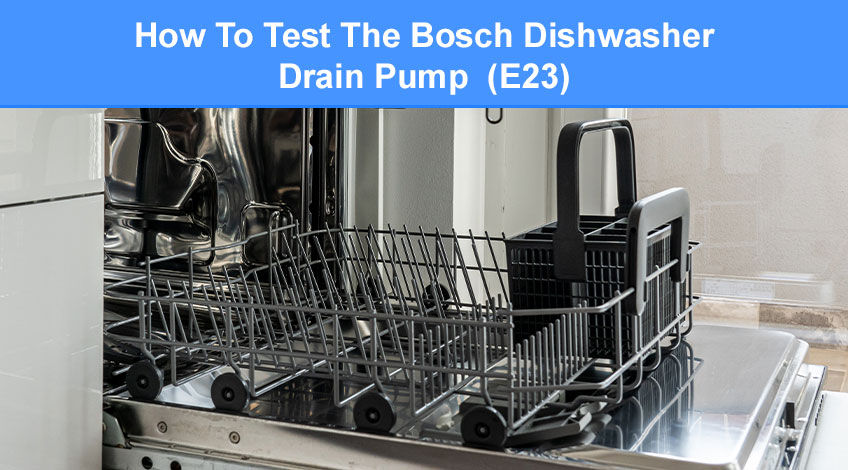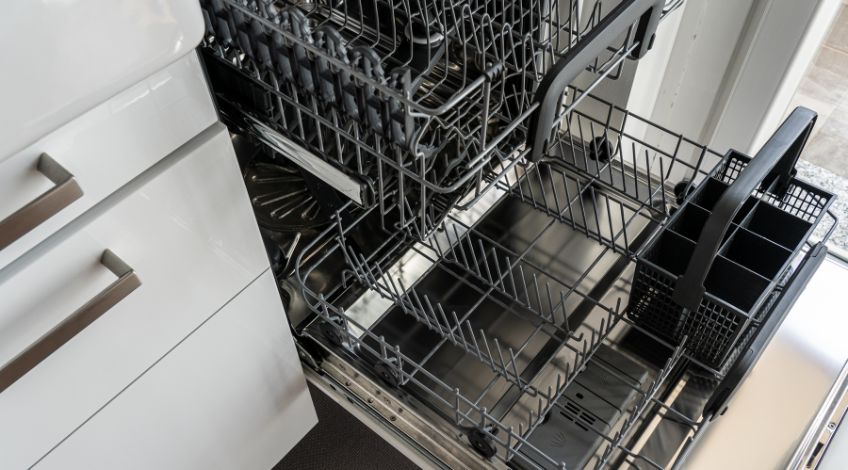
How To Test The Bosch Dishwasher Drain Pump (E23)
If you own a Bosch dishwasher and you have noticed water left in the bottom of the appliance after a cycle has completed, it indicates that the dishwasher isn’t draining correctly. There can be several reasons for this which can usually be checked and fixed without calling in an engineer.
In this article we look at the reasons why your Bosch dishwasher might not be draining correctly and how to resolve this problem.
What Causes A Bosch Dishwasher to Not Drain Properly?
The main reason that a Bosch dishwasher fails to drain correctly is usually because of a blockage. Which can occur in a number of places which include;
- The Filter
- The Drainage Hose
- The Air Gap
- The Drain Pump
You might also notice an E24 error code appears in the LED display. This is the code that indicates a blockage and if you see this error code you should do the following;
Check The Filter
The filter prevents any particles of food from settling back onto the dishes after they have been washed. As the water and detergent circulate through the dishwasher and over your dishes, food particles are washed away to be deposited in the filter.
You will need to clean the filter to ensure the smooth running of your dishwasher and allow it to drain as it should.
How To Clean The Filter
Cleaning the filter is a relatively easy task and shouldn’t take very long. All you need to do is;
- Remove The Lower Rack
The filter is located in the middle at the bottom of your dishwasher. To access it you will need to remove the bottom rack. - Remove The Filter
You will then see the filter which simply twists and then lifts from the housing. - Clean The Filter
You will need to wash both the filter and the cylinder using warm water and a small brush. - Refit The Filter
Once clean, lower the filter back into its housing and twist to secure, checking that the arrows line up perfectly.
Check The Drainage Hose
The problem could be as simple as the drainage hose has become twisted or kinked. All of the waste water from the dishwasher flows through the drainage hose and if it is twisted or kinked, it will cause a blockage which can stop the water draining away correctly.
Untwisting the hose will help to prevent any blockages from occurring. If the hose is actually blocked, you should remove it from the back of the dishwasher and use a plumber’s snake to free any blockage.
- Professional manual drain auger snake 7.7 meters will easily resolve slow or drain clogs, free length adjustment available. It fits most drain pipes: bathtub drains, bathroom drains, shower drains, sinks, downspouts, and sewer drains.
- Submachine gun super cool appearance design. It consists of strong recyclable ABS handle/drum and flexible manganese long steel snake, will quickly remove obstructions and be a lasting and excellent performance.
If it’s not the drainage hose, it could be that the waste pipe connected to the sink is blocked. If this is the case, you should notice that waste water from the sink doesn’t drain away too well.
You can use a plumber’s snake to clear this as well or pour equal amounts of bicarbonate of soda and white vinegar down the sink drain.
Check The Air Gap
The air gap is a contraption that separates 2 branches of hose with a gap of air to guarantee that no dirty water can contaminate the fresh water supply into the dishwasher.
One branch of the air gap connects to the dishwasher and the other branch connects to the waste pipe. The drainage hose carries the waste water from the dishwasher and curves upwards; it then drops through the air gap and into the second branch. It then continues on to the waste pipe.
The problem here can be that food particles get trapped in the actual air gap and prevent the water from flowing freely. To resolve this, all you need to do is remove the covering on the air gap (they either unscrew or just snap off). Then remove any debris inside before replacing the covering.
Check The Dishwasher’s Drain Pump

To be honest you won’t usually have to get this far, as the problem is usually one of the above mentioned faults. Plus you’ll typically know if it is the pump because the appliance will stop running completely and there will be lots of water left inside.
However, if you have noticed that the dishwasher has been taking longer than usual to drain, it could be that the drain pump is on its way out. Also, if you’ve tried all of the other solutions mentioned so far and there’s still standing water at the bottom of the dishwasher after it’s finished, that’s a good indicator that the drain pump is faulty.
If you hear an unusual humming sound coming from your dishwasher when it should be draining, this could be a sign of a blockage in the pump.
Of course if you can see water on the floor around the dishwasher, this is another good sign of a faulty drain pump.
How To Check The Drain Pump
The drain pump is located under the bottom spray arm so you will firstly need to remove the spray arm to get to the pump. All you need to do is;
- Remove the retaining cap on the spray arm
- Remove the spray arm, the food disposer blade, the upper impeller, the screen, pump housing, impeller hood, flat plate and lower impeller, as well as anything else along the way.
- Set your multimeter to Rx1 mode and touch the probes to the terminals on the pump.
- You should get a reading of zero or close to zero.
- Move one of the probes onto the bare metal of the housing, keeping the other probe on one of the terminals of the pump.
- This should also give a reading of zero or close to zero.
- If your readings show anything other than zero, you will need a new drain pump.
- 【MULTIPURPOSE USE】 Compact digital multimeter ideal for commercial and home use. Works as a voltmeter, ammeter, ohmmeter testing continuity, AC/ DC voltage, diode, transistor HFE, car battery tester
- 【RELIABLE PERFORMANCE】 This digital multi tester includes test leads and 9V battery, overcharge protection on all ranges, low battery indicator. Double insulation with a stand for good viewing angle
Can I Fit A New Drain Pump Myself?
It is possible to fit a new drain pump into your Bosch dishwasher yourself if you know what you’re doing. However, if you don’t feel confident or your appliance is still under warranty, you should contact Bosch or an engineer to find the fault and repair it for you.
Just taking the drain pump apart yourself could make any warranty invalid.
How To Fit A New Drain Pump
If you do feel confident and you have received a replacement drain pump and you’d like to fit it yourself, just do the following;
- Disconnect the dishwasher from the power supply.
- Remove the spray arm and other bits to access the drain pump.
- Remove the top panel, all side panels and the kick plate from your dishwasher.
- Disconnect the cables from the water detection sensor to get to the drain pump.
- Twist the drain pump clockwise to free it from its housing.
- Disconnect the electrical plugs from the drain pump.
- Connect the electrical plugs into the new drain pump.
- Place the new drain plug into the housing and ensure it is fitted correctly then twist anti-clockwise to secure.
- Then reverse all processes from step 4.
After the dishwasher has been safely reassembled, run a rinse only cycle to ensure the drain pump is working correctly.
How To Prevent Blockages
There’s an old saying that says “prevention is better than cure” and that is definitely true when it comes to clogged dishwashers. A clogged dishwasher can cause you many problems including a flooded home and dirty dishes.
There are a few simple measures you can take to prevent this problem from occurring. These include;
- Removing food scraps before putting dishes in the dishwasher.
- Using a hot wash cycle to clean your dishwasher periodically.
- Cleaning the filter on a regular basis.
Performing these simple tasks can keep your dishwasher running smoothly and draining all of the wastewater away.
SEE ALSO: Should You Turn Off Taps When Dishwasher Not In Use?
Frequently Asked Questions
Error code E23 on a Bosch dishwasher indicates that there is an electrical fault with the drain pump. It usually means a new drain pump is needed.
The most common reason for a Bosch dishwasher to not drain is because of a clogged filter, clogged drainage hose or problems with the drain pump.
Depending on the model of Bosch dishwasher you own, a drain pump will cost anywhere between £15 to £45.






